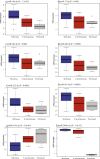Differential expression of miRNAs in pancreatobiliary type of periampullary adenocarcinoma and its associated stroma
- PMID: 26590090
- PMCID: PMC5528959
- DOI: 10.1016/j.molonc.2015.10.011
Differential expression of miRNAs in pancreatobiliary type of periampullary adenocarcinoma and its associated stroma
Abstract
Periampullary adenocarcinomas can be of two histological subtypes, intestinal or pancreatobiliary. The latter is more frequent and aggressive, and characterized by a prominent desmoplastic stroma, which is tightly related to the biology of the cancer, including its poor response to chemotherapy. Whereas miRNAs are known to regulate various cellular processes and interactions between cells, their exact role in periampullary carcinoma remains to be characterized, especially with respect to the prominent stromal component of pancreatobiliary type cancers. The present study aimed at elucidating this role by miRNA expression profiling of the carcinomatous and stromal component in twenty periampullary adenocarcinomas of pancreatobiliary type. miRNA expression profiles were compared between carcinoma cells, stromal cells and normal tissue samples. A total of 43 miRNAs were found to be differentially expressed between carcinoma and stroma of which 11 belong to three miRNA families (miR-17, miR-15 and miR-515). The levels of expression of miRNAs miR-17, miR-20a, miR-20b, miR-223, miR-10b, miR-2964a and miR-342 were observed to be higher and miR-519e to be lower in the stromal component compared to the carcinomatous and normal components. They follow a trend where expression in stroma is highest followed by carcinoma and then normal tissue. Pathway analysis revealed that pathways regulating tumor-stroma interactions such as ECM interaction remodeling, epithelial-mesenchymal transition, focal adhesion pathway, TGF-beta, MAPK signaling, axon guidance and endocytosis were differently regulated. The miRNA-mRNA mediated interactions between carcinoma and stromal cells add new knowledge regarding tumor-stroma interactions.
Keywords: Bioinformatics and statistical analyses; Pathway analysis; Periampullary adenocarcinoma; Stromal reaction; Tumor microenvironment; Tumor-stroma interaction; miRNA/mRNA expression profiling.
Copyright © 2015 Federation of European Biochemical Societies. Published by Elsevier B.V. All rights reserved.
Figures






References
-
- Bastian, M. , Heymann, S. , Jacomy, M. , 2009. Gephi: Anopen source software for exploring and manipulating networks. International AAAI Conference on Weblogs and Social Media
-
- Benjamini, Y. , Hochberg, Y. , 1995. Controlling the false discovery rate: a practical and powerful approach to multiple testing. J. Roy. Stat. Soc. B. 57, 289–300.
-
- Betel, D. , Wilson, M. , Gabow, A. , Marks, D.S. , Sander, C. , 2008. The microRNA.org resource: targets and expression. Nucleic Acids Res. 36, D149–D153. - PMC - PubMed
Further reading
-
- Web links
-
- Cancer registry of Norway: http://www.kreftregisteret.no/en/.
-
- miRbase: http://www.mirbase.org/ (release 21, June, 2014).
-
- miRNA.org: http://www.microrna.org/microrna/home.do (release August, 2010).
-
- miRTarBase: http://mirtarbase.mbc.nctu.edu.tw/ (Release 4.5, November 1, 2013).
Publication types
MeSH terms
Substances
LinkOut - more resources
Full Text Sources
Other Literature Sources
Medical
Molecular Biology Databases

